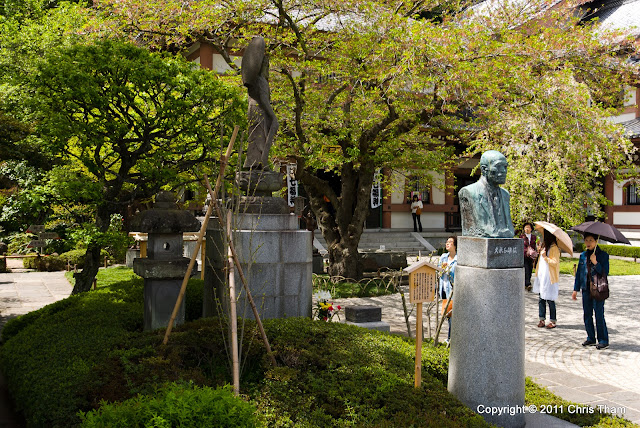A closeup of the two statues in front of Jishoin:
And a closeup of the main gate:
Just behind the main gate is a small, but exquisite Japanese garden:
One of the features of this garden is a pool containing turtles:
The garden also features some nice stone lanterns:
On the other side of the garden is a koi pond:
Some other interesting water features of the garden:
This is a sculpture of Buddha's feet - I'm assuming it's not true to scale:
And an interesting succulent plant:
Another interesting plant that looks like tied shallots:
Most of the temple buildings are on a higher plateau, so we started to climb up the steps. Midway is the Jizo Hall (地蔵), which houses Fukuju-Jizo:
"Happy Jizo" is the Bodhisattva usually associated with the protection of children, hence the smiling face:
This section of the temple is full of tiny Jizo statues, however I was saddened by the realisation that each statue has probably been donated by parents who have lost a child, and this is their way of remembering the one that will never grow to become an adult:
There's a very pretty "garden of Jizo statues" with a great view of Kamakura town in the background:
There's also a very interesting pond in the shape of a swastika (note that the Buddhist swastika rotates clockwise and is a symbol of the sun, whereas the Nazi swastika rotates anti-clockwise and is the symbol of magic and the occult):
The first hall when we reached the upper plateau was Amida Hall (阿弥陀堂):
Inside is the beautiful golden statue of Amida Yakuyoke Buddha (阿弥陀如来坐) [photography is actually forbidden inside any of the halls, but I took these ones from just outside the entrance]:
Some schoolkids on an excursion visiting this hall:
There's also a very small Inari shrine here, called the Kagikara Inari (かぎから稲荷):
And a graveyard on top of a flight of stairs:
This is the Shourou (鐘楼) bellfry:
Not quite sure what this is - something to do with cleaning or bathing?
Outside the Kannon Hall (観音堂) - this contains the magnificent Hase Kannon statue of the Avalokitesvara Bodhisattva (Goddess of Mercy) with 11 heads carved out of a huge camphor tree (unfortunately, we were not allowed to take photographs of this statue):
A Japanese family paying their respects outside the Kannondou:
Some stone lanterns outside the Kannondou:
This is the image of Kannon from the Hasedera web site:
Daikoku Hall (大黒堂) contains a statue of Daikokuten - the Japanese God of Wealth (Harvest) or Household (Kitchen):
Again, no photos allowed inside, but here's a picture from the Hasedera web site:
Another sculpture of Buddha's feet - this one is even bigger (the warning sign next to the sculpture says please don't step on the feet):
And these are are interesting copper sculptures arranged around a stone sculpture of the Buddha:
A small pond between buildings:
This is a rinzou or revolving bookshelf for storing sutras (if you recall, on Day 3 we visited a hall full of these bookshelves at the Toushouguu shrine in Kamakura). Members of the public are allowed to rotate this one:
A statue of Benzaiten with eight arms (she is a sea goddess and patron the arts and music):
After this, we walked along a steep path from which there were several vantage points where we saw wonderful views of Kamakura town, including the Yuigahama/Zaimokuza Beaches, Sagami Bay and Miura Peninsula:
Some beautiful irises:
Some beautiful jizo statues set next to a statue of the Buddha with a great view of Kamakura surroundings:
At the observation deck, where some schoolgirls noticed me taking a photo of them:
And bird also posing for me:
A statue of Holy man Tokudo, founder of the temple:
Some beautiful white lilies next to a statue:
Finally there is a cave at the bottom level called the Benten-kutsu where images of Benzaiten and her 16 children are carved on the walls:































































































No comments:
Post a Comment